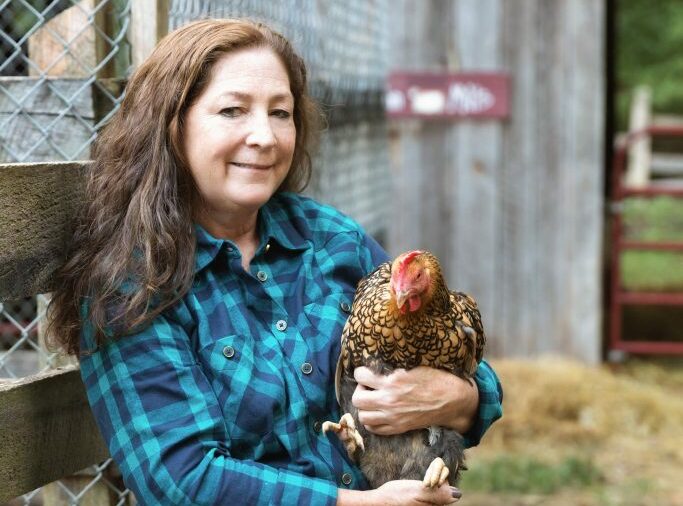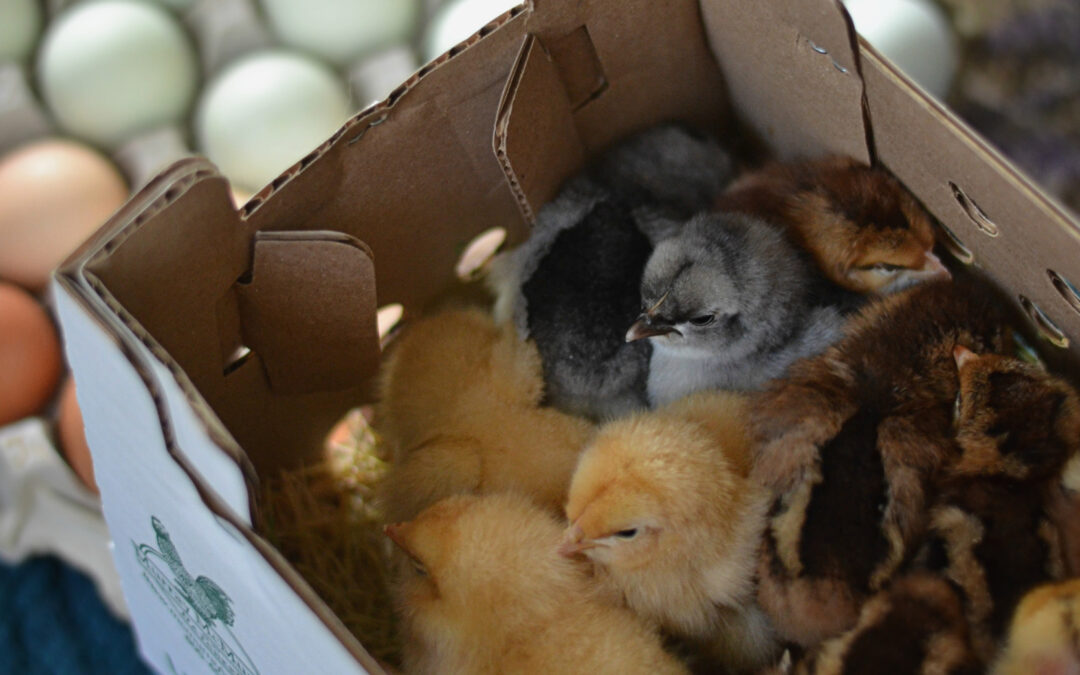Our thoughts on brooding Fall chicks have changed over our years of chicken keeping experience.
We were strongly in the Spring chicks camp for most of our chicken tending days, until the last two years, when we tried bringing chicks in later in the Summer.
When the weather in our area is at its hottest point, we have readied the brooder, purchased chick feed, and retrieved the box of chicks from the post office. While heat can be a threat to poultry, the chicks in the first few days of life need warmth in order to live. Even a slight chill can send them into a downward spiral.

USING AN OUTDOOR BROODER WHEN BROODING FALL CHICKS
Several years ago, we put together a sturdy outdoor brooder, and placed it in a shed. The shed has electricity for the brooder warmers. Having this outdoor brooder has saved the house from the mess chicks can create. The larger size allows the chicks to stay in the brooder longer, getting them ever closer to the day they can integrate with the older flocks.
Placing the brooder in the shed keeps the chicks safer from predators, and is only a few degrees different than the outside temperature. A fan in the building, not pointed at the brooder, reduces the presence of flies.
Benefits of Starting Chicks in the Fall
Now that we’ve discussed how the chicks are housed for brooding Fall chicks or Summer chicks, what have I observed?
WARMER TEMPERATURES
First, our late Summer / Fall chicks arrived in great condition with no signs of chilling. They were more active from day one, eating and drinking well. They rarely spent time huddled under the warmers. Having a low-stress start in life is the best! The chicks spent very little time under the chick warmers — they were out eating and drinking most of the day. By the end of week three, as feathers were developing quite well, I removed the brooder warmers to give them more room. At that point we were having a heat wave anyway and they were mostly sitting on top of the warmers, not under.
In addition to needing less of a heat supply, the late Summer / Fall chicks had absolutely no poopy butt, (pasty butt). I noticed this with both years of getting chicks in late July. Warmer weather, increased water intake, or eating more food? Maybe a combination of all the factors led to less digestive problems, and healthier chicks!

The next observation is purely my observation. I did not weigh the chicks so I cannot substantiate the claim, but it appeard they grew faster than chicks we started in March or even February. We also lost very few. This year we lost one, but it was tinier than the others to begin with.
LOWER MINIMUMS
When buying hatchery chicks in the winter or early spring, you may have to purchase a minimum number of birds. This is so they can keep each other warm during travel. Many hatcheries lift this requirement or lower the minimum purchase once the weather is consistently warm. It still is a good idea and commonly recognized, that you start with 3 or more chicks for your beginning flock.
Transitioning Chicks Into An Existing Flock
Brooding Fall chicks will transition into juvenile chicks ready for the coop before you know it. After raising your Summer or Fall brooding flock, it will be time to transition your Fall chicks to the big kids coop. Once my chicks are fully feathered, and about half the size of the full-grown flock, I begin the transition. Usually this occurs around 12 weeks, but it can vary.
Moving new chicks to the current coop takes a few days or longer. Acclimating the chicks to the behavior of the older residents is best handled slowly. Pecking order is a real threat to their well-being.
I use some sort of pen inside the chicken run. In the pen, the growing chicks have their own water and chick food. The older hens and any roosters, can see them, and slowly get used to them being in the run. At night you will need to move them to a secure dog crate or pen inside the coop, or return them to the brooder for sleeping — with Fall chicks you’ll want to watch nighttime temperatures when deciding where they will sleep. This transition can be tedious, but the procedure will pay off with a calmer flock.
After a few days, I begin to let the growing pullets out during the day. Providing them some hiding spaces from bullying helps them get acclimated slowly. Hiding spaces can be large potted plants, boards leaned against the fence, even a cardboard box. Out of sight, out of mind works in this situation. If the older birds don’t see them, the pullets get a break from being hen pecked.

Fresh Eggs from New Layers
Soon your new pullets will begin to lay eggs. A few things will be happening in your existing flock at this point in late Fall. Your mature hens will be molting and growing in new feathers for winter. The older girls will also likely be taking an egg-laying break. Growing new feathers takes a toll on them and their protein intake will be going towards new feather growth. It’s very common to see a drastic drop in egg production during and after molt. Some hens will not lay again until after the Spring equinox.
Here come the new pullets, ready and eager to fill the egg cartons. If you are selling eggs to your community, the new layers will keep you in business over the Winter. Egg production differs by breed, but a brand new, healthy egg-layer will continue to lay eggs through the Winter despite the cold.
Hatching or brooding Fall chicks can be a great choice. Not only do you skip the crazy chick season in the Spring when everyone is rushing to get their chick order, you may end up with healthier, more robust chicks when they arrive in the late Summer or Fall.

Janet Garman of Timber Creek Farm is an author, fiber artist and farmers with a love for animals and sustainable living. Janet has a degree in large animal farm management and animal science from the University of Maryland, and helps others learn to raise livestock, chickens, ducks, rabbits, and manage a small farm. Her articles on keeping animals, small farms and homesteading can be found in many popular websites. Janet has is the author 50 Do-it-Yourself Projects for Keeping Chickens, Chickens from Scratch and many books about fiber arts and farming with animals.
Photos courtesy of Janet Garman and Ashley Stratton.

